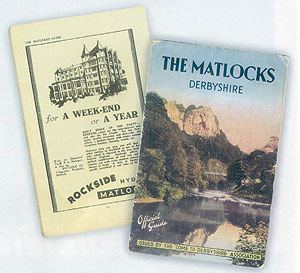|
Magazine & Newspaper Articles> Reflections selection> This Page |
| Rockside Hydro: Watered-Down Future ...* |
| One of a series of articles published in "Reflections" more than two decades ago |
| ...for a glorious icon of the age of the hydro |
|
|||||||||
| Riber Castle isn't Matlock's only landmark building teetering on the edge of survival. Although the Castle's future is still far from assured another famous landmark, the former Rockside Hydro, has been thrown a lifeline - but only just in the nick of time. Michael Fay reports | ||||||||||
|
||||||||||
A positive obsession to Victorians and Edwardians, and a fashionable frolic in the twenties and thirties, hydropathy was a victim of the Second World War. Shabby and outdated, some of the hydros struggled on for a few post-war years, but their era drew to a close half a century ago. Surprisingly, given the 1960s enthusiasm to tear down Victorian buildings, almost all the old hydros survive to this day. The first, largest and arguably, least attractive architecturally, Smedley's has been the County Council's headquarters since 1956; Lilybank is a residential home for the elderly, Chatsworth is a County Council office, Jackson House is an hotel, and Derbyshire Records Office is in the former Oldham Hydro which served as the Ernest Bailey Grammar School for many years. They're all still there in new roles with reasonably assured futures. And then there's Rockside - once one of the most glittering and fashionable of them all but now reduced to a ravaged, vandalised shell, an awful testimony to failed promises, neglect and indifference. Still from the top of Riber you can see Rockside in a prominent position on the hillside above Smedleys. It looks different, more impressive, more stylish - tall and elegant twin towers and altogether more modernlooking. Appearances aren't deceptive. The original buildings date from the 1850s, so were in almost at the start after John Smedley, returning from European business visits, decided that Matlock was quite capable of emulating the German spas and fired with his usual zeal, set about building his own hydro. A continental spa Rockside's golden age was in the first half of the 20th century, rather than in the 19th when Smedley's philosophy that hydropathy had to be worthy, improving but not necessarily enjoyable, held sway. After its ultra-modern revamp in 1906, Rockside was different - it was for people who wanted some fun and enjoyment. If your health improved - then so much the better, but you rather gained the impression that the infirm and elderly would be better off booking into Smedleys. An elegant art-deco-style advertisement for Rockside from the 1930s summed it up in its headline: For a weekend or a year; don't break up the party. The text goes on to emphasise that Rockside is a modern hotel with choice cuisine, luxurious lounges, dancing, tennis and other pleasures. But the party was broken up, permanently as it happened, from September 1939. During the war, Rockside like other hydros was requisitioned for military purposes and, for a time, was a convalescent home for injured service personnel. It never re-opened as a hydro but was sold to the County Council whose leader, Charles White, was extremely keen to see his home town of Matlock benefit from new developments. Teacher-training college The County Council, ironically the protector of listed buildings of architectural and historic importance, found to its increasing unease that one of Matlock's finest buildings was rapidly and visibly deteriorating, right on its own doorstep. The building was targeted by vandals, would-be arsonists, and thieves who were not slow to recognise the value of the original art-nouveau style fittings. The building was systematically stripped of most of its attractive and unique furnishings. A developer arrived on the scene in 1995 with a plan to convert the landmark tower block into ten apartments, renovate much of the older building, and provide ten new homes in the grounds. This was an enabling package through which new building financed the cost of restoring the original. The developer was not allowed to build more than six homes before re-roofing and carrying out many permanent repairs to the old hydro. But the developer went into liquidation after building five new homes and without carrying out any restoration work. Another developer, the London based Dubarry arrived on the scene and proposed a restoration package but it too ran into difficulties. In December 2001 their managing director claimed: "We are very keen to start work on the development, but the Council are making it difficult."
On the plus side, however, a building which just over a year was condemned as a time bomb, and drew a 345-signature petition from local residents urging its demolition, will be saved. As a report to the District Council points out: "Many of the original features have sadly been lost or fallen into disrepair. The conversion of the tower and hydro will safeguard the future of a listed building at considerable risk for many years. The proposals respect the integrity of the building." For a once-proud building - now reduced to such a state that the fire brigade regard it as too dangerous to enter - some respect and integrity seems long overdue. |
||||||||||
|
*This is a copy of an article published in "Reflections" in October 2003, Vol. 12 Issue 141, pp.19-20. "Reflections" is Derbyshire's largest-circulation targeted lifestyle magazine, serving Dronfield, Chesterfield, Matlock and Bakewell areas. The article is reproduced here with the very kind permission and written consent of the author, Michael Fay, and Bannister Publications Ltd. |
||||||||||
There is more on site information
|




 Water Cures
Water Cures